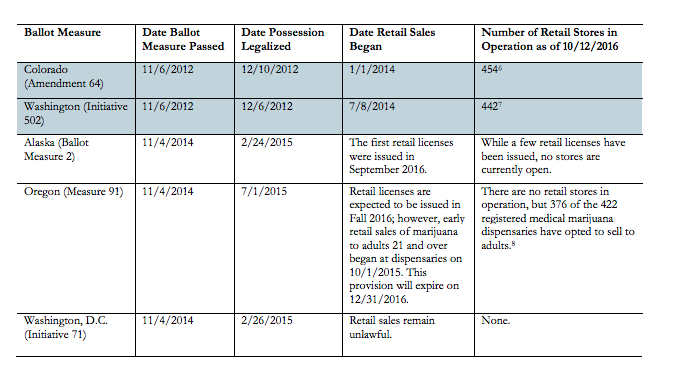
When Colorado and Washington became the first states to legalize recreational marijuana in 2012, opponents of the measures warned that ending the longstanding prohibition on weed would wreak havoc on society. The fiscal benefits associated with taxed and regulated marijuana wouldn’t be worthwhile, they said, because more children would end up using the drug and high drivers would terrorize the roadways.
Those dire predictions haven’t come true, according a new report by the Drug Policy Alliance, a nonprofit that lobbies for progressive reform of drug laws. In fact, legalization has had a negligible effect on rates of youth marijuana use and traffic fatalities in Colorado and Washington ― and in Alaska, Oregon and Washington, D.C., which have all since approved marijuana for recreational use. At the same time, marijuana arrests have plummeted and total revenue from legal weed has surged past $500 million.
“This report shows that a lot of those fears don’t come to fruition in the case of legalization,” said Joy Haviland, staff attorney at DPA. “It’s clear that prohibition has not worked, so states need a new solution going forward.”
The study looked at drug use surveys of high school students in Alaska, Colorado, Oregon and Washington, which show that both current and lifetime marijuana use among youth has remained stable after legalization.
Marijuana legalization has made no discernible mark on traffic fatalities in Colorado and Washington, the report finds, and total arrests for impaired driving have declined in those states. Although more Washington drivers involved in fatal crashes have tested positive for the psychoactive compound THC in recent years, the report notes that links between impairment and THC levels in a driver’s system have not been fully established. In other words, just because a driver has THC in their system at the time of an accident does not mean they were impaired. Furthermore, the report says this increase could be due to enhanced reporting and testing standards enacted in Washington post-legalization.
The new marijuana laws have had a significant financial effect, the report finds. Much of this is due to savings to police and the criminal justice system, which are no longer inundated with small-time marijuana cases.
In Colorado, cops made 46 percent fewer marijuana arrests between 2012 and 2014. Washington saw a 98 percent reduction in the total number of low-level marijuana court filings, from 6,879 in 2011 to only 120 in 2013. In Washington, D.C., marijuana arrests fell 85 percent from 2014 to 2015, while arrests for possession alone fell by 98 percent in the same period, to just 32 in 2015.
In Oregon and Alaska, where there are still no retail weed stores, marijuana arrests have also decreased considerably in the past few years.
“By no longer arresting and prosecuting possession and other low-level marijuana offenses, states are saving hundreds of millions of dollars and thousands of adults are no longer getting stopped, arrested, charged, or convicted for the unlawful possession of marijuana,” the report says.
Although arrests have been scaled back, studies have shown persistent racial disparities in enforcement, with blacks and Latinos still more likely to be arrested for marijuana crimes than whites.
Taxed and regulated marijuana has also generated substantial financial windfalls for Colorado and Washington. Both states exceeded sales projections last year, bringing in $129 million and $220 million, respectively.

This data, while encouraging, is still preliminary, Haviland said. Retail sales of marijuana in Colorado and Washington have only been going on since 2014, and legalization measures in Alaska, Oregon and D.C. went into place last year. It could take years to get a clearer picture of the total impact of legalization, but the report does cast doubt on some of the most alarmist arguments from drug warriors.

The DPA report adds to a growing body of research on the impact of legalizing marijuana at the state level. This includes a recent study by the Cato Institute, which found that there has been no convincing connection between ending weed prohibition and crime or drug abuse rates.
All of this analysis is dealing with a very limited data set. But that could change soon, as voters in Arizona, California, Maine, Massachusetts and Nevada prepare to consider similar measures to legalize cannabis on Election Day. With polling showing high levels of support for the initiatives, nearly 25 percent of Americans could soon be living in states with legal weed.
Reports like this suggest that would be a positive development, Haviland said.
“By shifting away from drug prohibition and marijuana prohibition and instead focusing on public health, states are making positive change,” she said.
Clarification: Language has been amended to indicate that, while one can purchase marijuana for recreational use at medical dispensaries in Oregon, wider retail operations have not yet begun in the state.
Read the entire report below:
